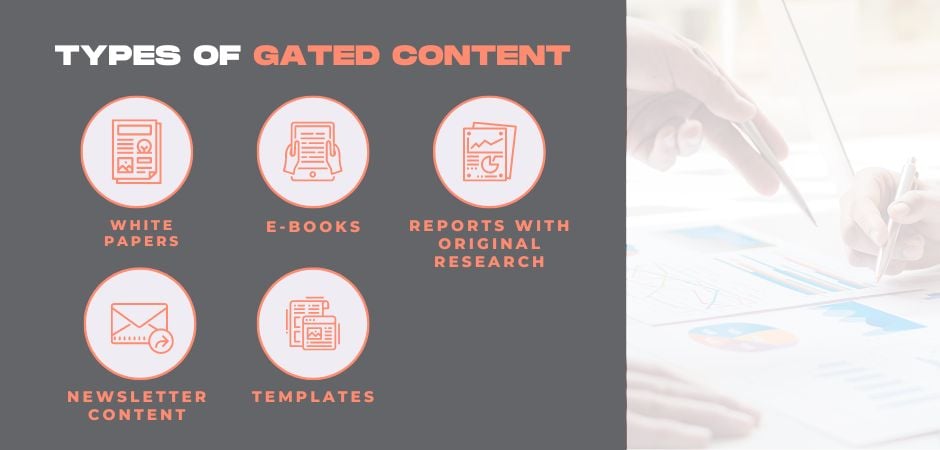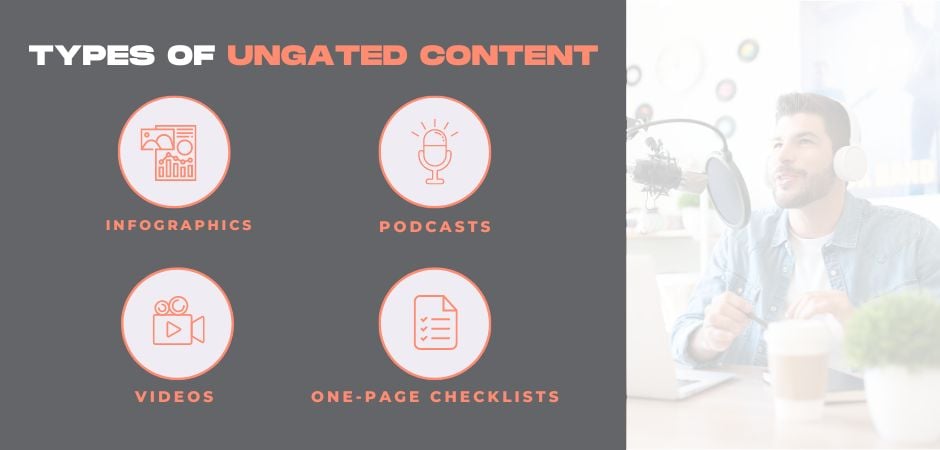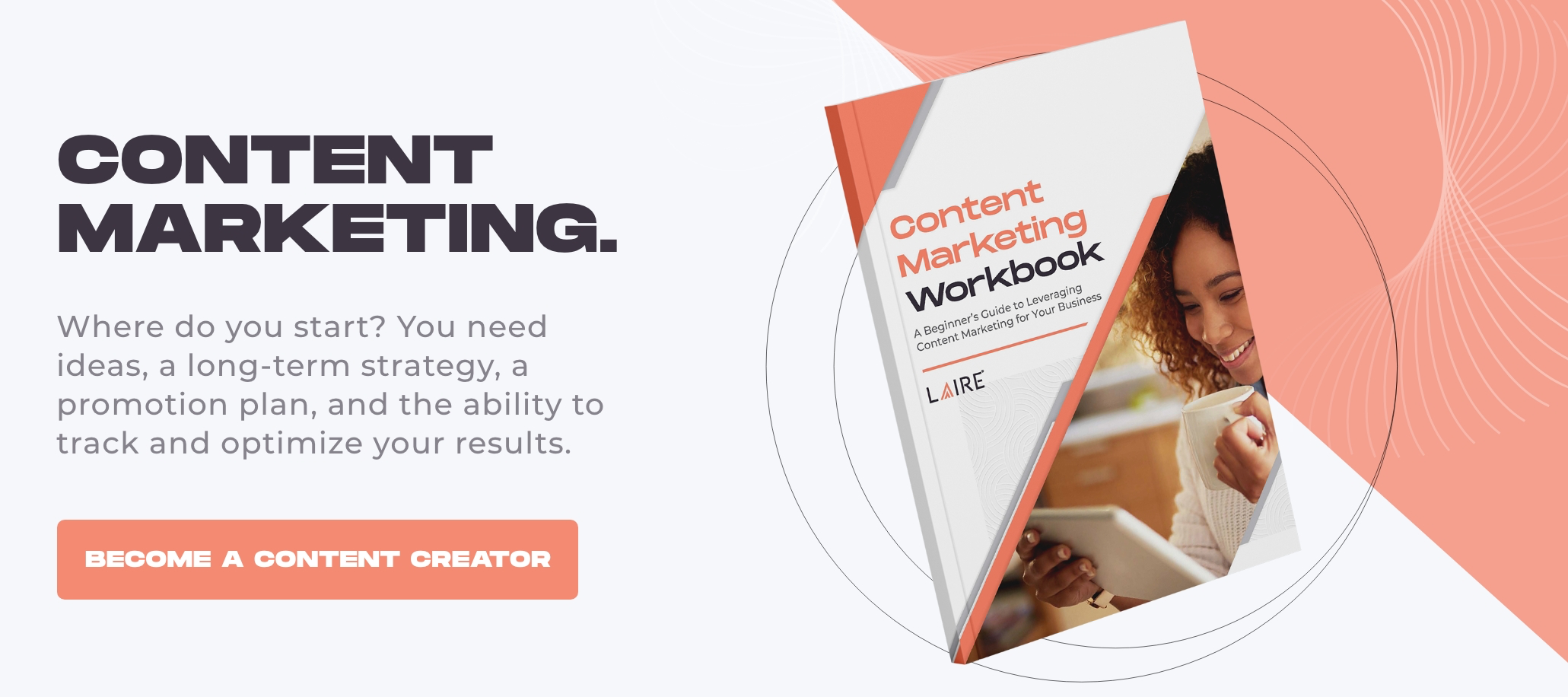In the world of content marketing, the debate over gated content versus ungated content continues. Some argue that gating content is the optimal way to generate leads while others claim that it's a turnoff for readers. So, what's the truth?
In this article, we'll take a closer look at both gated and ungated content while exploring examples of each. Then, you can make an informed decision that makes the most sense for your unique business model.
What Is Gated Content?
Gated content is an effective content marketing strategy where you launch a piece of content behind a form. Once the form has been filled out, the user gains full access to the content.
The idea behind gated content is this: Your ideal customer gets valuable content, while your company gets their contact information for future lead generation efforts. It’s a win-win.
So, what do these forms entail? Typically, they request basic information such as first and last name, as well as an email address. But, some more detailed forms may request additional information such as phone number, job title, location, or other complex questions.
As a thriving business, having gated content is a great way to collect and nurture leads throughout their buying journey. By providing individuals with content that's relevant to their needs, gated content can effectively capture their interest in your services (or products) — turning them into possible customers down the line.
Gated Content Examples
Creating effective gated content offers limitless possibilities that can be tailored to your target audience's interests and needs. Common examples of gated content include:
- eBooks
- Guides
- Checklists
- Workbooks
- Masterclasses
- Webinars

To ensure gated content success, it's crucial to analyze your data and make sure that the content provides value and resonates with your audience. By doing so, you can maximize lead generation and customer engagement.
Benefits and Drawbacks of Gated Content
The primary benefit of gated content is its ability to serve as a lead magnet that will help you capture more leads. Few things are more valuable to a business than quality leads, and publishing gated content is a great way to acquire them.
Using gated content for lead generation purposes also allows you to create segmented lists based on the type of content that your visitors are interested in. For example, if you are a marketing agency that offers both content marketing and business coaching services, you could offer two different pieces of gated content: one on content marketing and one on business coaching.
The visitors who download the content marketing piece could then be segmented into a list that you target your content marketing services toward. On the other hand, the visitors who download the business coaching piece could be segmented into a list that you target with your business coaching services.
The downside of gated content is that it’s generally not intended to improve your website's search engine optimization (SEO). This means that it won't bring in any organic traffic.
Gated Content Best Practices
Before gating a piece of content, it’s best to follow a few best practices before diving head first. Here are the results-driven steps we follow each time we launch gated content for our B2B clients:
1. Ideate an Offer (That Converts)
To figure out what kind of content offers to launch, look at the current content on your site to see what’s performing well and what’s not.
Take a deep dive into your site's analytics and identify the keywords and topics that are thriving. Is there a particular pain point that your audience is searching for answers to? Or, is there a trending topic that's generating a lot of buzz in your industry?
Once you've identified these high-performing topics, it's time to get to work creating a content offer that will speak directly to your audience's needs.
2. Keep the Form Simple
After the gated content offer comes the form. The best practice for this is to keep it short and simple. Ask too many questions and you may turn your audience ice cold!
Remember, the form is a gateway to your valuable content, so make sure it's inviting and user-friendly.
3. Make the Landing Page Clear
Your landing page paints the full picture of what your audience will receive after filling out the form. Keep your landing page easy to understand and highlight the benefits of the offer in a simplified format.
Will they gain a new skill set, save time, or increase their ROI? Whatever the benefits are, make sure those benefits are front and center on your landing page. After all, your audience wants to know what's in it for them before they hand over their personal information.
4. Have a Quick Follow-Up
Lastly, don't keep your audience waiting for that must-have guide, essential checklist, or another piece of valuable content. Give it to them right away on the next page so they can start benefiting from it immediately.
And why stop there? For an extra measure, send it straight to their email inbox too, ensuring they have quick and easy access to your content whenever they need it.
What Is Ungated Content?
Ungated content is simply content you offer freely to your audience without requiring anything in exchange. Instead of being gated behind a form, ungated content is easily accessible to anyone who wants to view it — without having to give over valuable contact information.
But just because ungated content is offered freely, it doesn't mean it won't provide your company any value. Populating your website with high-quality content is the most effective way to improve SEO and, in turn, increase organic traffic.
From blog articles to video libraries and even case studies, ungated content can be a great way to get those who are at the awareness level of the buying process more interested in what your company has to offer.
Ungated Content Examples
Ungated content is a popular choice because it provides your audience with valuable information without any barriers. Some common examples of ungated content include:
- Blog articles
- Video libraries
- Case studies
- Podcast episodes
Let’s face it, most consumers don’t want to give their contact information over to just anyone. It takes time before they may trust you with it, and what better way to build that trust than ungated content?
Benefits and Drawbacks of Ungated Content
If you’d like to use your content as a form of inbound marketing, you'll want to leave it ungated. There’s nothing that search engine algorithms value more than quality content when it comes to determining which websites rank at the top of search results. This is especially true if you create your content with SEO in mind.
In addition to bringing more eyes to your website, ungated content can also help you provide readers with the messages you feel are most likely to convert them into customers.
At the very least, ungated content can improve your brand awareness. At its best, ungated content can serve as an impactful part of your sales funnel, soft-selling your products or services by providing your visitors with content that is carefully designed to nudge them toward making a purchase.
The key drawback of ungated content is the fact that you might not be fully capitalizing on all of the value that an individual piece of content has to offer.
When Should You Ungate Content?
First things first: Some pieces of content are better suited as ungated blog posts than gated, downloadable content.
If your content is somewhat generic — meaning it's not that different from content that visitors could easily find somewhere else — it may not offer as much value as a lead magnet. It can still offer a lot of value in terms of SEO and brand awareness though.
Of course, if SEO and brand awareness are your primary goals, creating content that is meant to be left ungated is the best way to accomplish those goals.
On the other hand, there are several instances where gating your content is likely to be the best approach. If you’re offering content that is especially alluring or valuable, gating that content could be a great way to capitalize on its value and generate leads. Additionally, if gathering analytics is a priority for your company, gated content is a great tool to use.
Gated Content vs Ungated Content: Which Is Best?
So, time for the moment you’ve been waiting for … which one is better: gated content or ungated content?
As B2B marketing experts, we believe that both gated and ungated content play a pivotal role in your content marketing strategy. It’s all a balancing act.
Ungated content can be a powerful tool for building brand awareness, increasing website traffic, and establishing thought leadership. On the flip side, gated content is an essential tool for lead generation and nurturing. By gating your content, you can collect valuable contact information and use it to build relationships with potential customers over time.
To see real growth, you will want to take a hybrid approach and utilize both of these methods in your company’s content marketing.
The majority of the content you produce should be left ungated to improve your website's SEO, boost brand awareness, and communicate messages that are most likely to convert your visitors into paying customers. Content that’s especially valuable to your audience, however, may be best behind a gate where readers must fill out a form in order to download it.
How LAIRE Can Help You Take Your Content Marketing to the Next Level
Tired of pumping out content with no return? We totally get it. It’s frustrating to put energy into content creation and not get any traction. That’s why we created our Content Marketing Workbook.
Discover original tips and strategies in this exclusive workbook to effectively generate content ideas, create a long-term content strategy, promote your content, and analyze its effectiveness. All we ask for in return is your email address. (See what we did there?)


